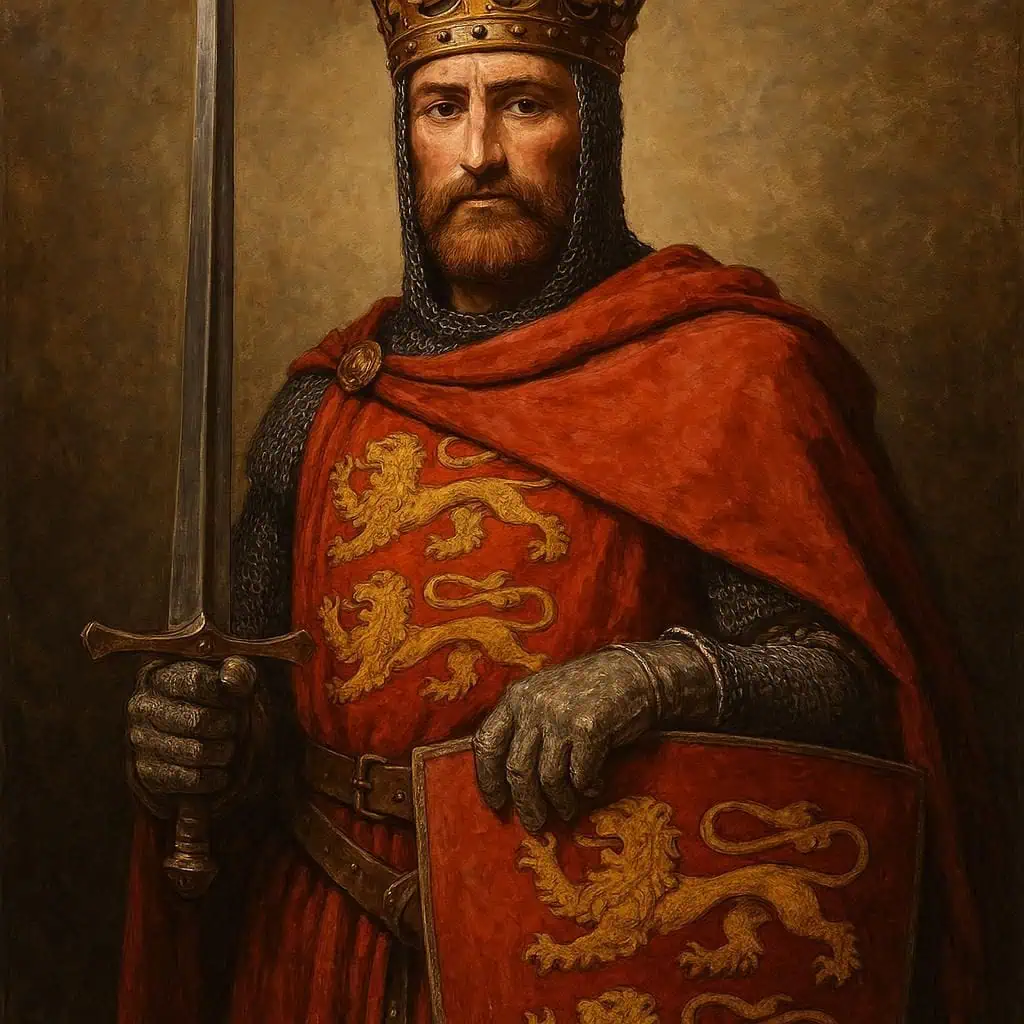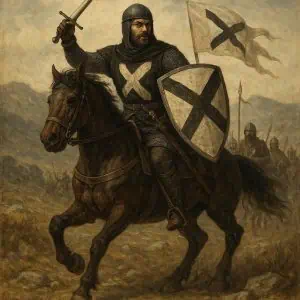Richard the Lionheart (1189–1199), also known as Richard I of England, was one of the most celebrated monarchs of the medieval era. Renowned for his military skill, leadership, and courage, he earned his legendary title — “the Lionheart” — for his fearless role in the Third Crusade. Before ascending the English throne, Richard held extensive territories across continental Europe, including Aquitaine, Anjou, and Normandy, reflecting England’s vast reach during the 12th century. Though he spent little time in his kingdom, Richard’s reign left a lasting mark on English royal history, crusader warfare, and the enduring image of the chivalric king.

During his reign as King of England, Richard the Lionheart became one of the most renowned leaders of the Third Crusade — a massive campaign aimed at reclaiming Jerusalem from Saladin, the powerful Sultan of Egypt and Syria. Richard’s unmatched courage, military skill, and leadership on the battlefield earned him his famous epithet, “the Lionheart.” Though he did not succeed in recapturing Jerusalem, his victories against Muslim forces, including the battles of Acre and Arsuf, cemented his reputation as one of the greatest Crusader kings of the medieval era.

Richard before Kingship
Henry II was the English monarch and Richard the Lionheart was his third son. During Henry II’s lifetime, he faced a rebellion from a number of his sons including Richard. After the failure of the rebellion, Henry II forgave Richard and made him king of the Duchy of Aquitaine which was a part of England’s Continental territories.

Richard’s disagreements with Henry resurfaced later and he aligned himself with the French king Philip in a bid to withstand his father’s power.
In time, Richard stood victorious in his conflict with Henry II and was named successor by Henry just before his death in 1189.
💡 Did You Know? Fascinating Facts About Richard the Lionheart
Despite being King of England, Richard spent little time in his realm and spoke the Old French dialect common to his mother’s court in Aquitaine.
Chronicles described Richard as a warrior who led from the front, inspiring troops with unmatched courage during the Third Crusade.
Though enemies, both leaders admired each other’s honor and chivalry — even exchanging gifts during truces.
Returning through Europe, he was held for ransom by Duke Leopold of Austria — an event that bankrupted England to secure his release.
In 1199, Richard was mortally wounded by a crossbow bolt while besieging the castle of Châlus-Chabrol in Limousin.
Richard the Lionheart Preparations for the Crusade
In 1188, Jerusalem had fallen to the forces of Saladin. Richard had vowed to participate in the effort to liberate the city before his coronation.
After he ascended the throne, he launched a large-scale effort to bring together a suitable army and fleet for the Third Crusade.

In gathering the funds for the Crusade, Richard sold notable official positions and even imposed the Saladin tithe to bring sufficient money in the treasury.
After bringing together a sufficiently large army, Richard set out to join the Third Crusade in 1190. He was joined in his campaign by Philip II of France.

Richard the Lionheart as a Crusader
The earliest victories for Richard the Lionheart and the accompanying Crusader forces came in 1191 when Acre fell to their control.
His forces later won a significant victory over the forces of Saladin in the Battle of Arsuf the same year. Another major victory for the Crusader army under Richard came at the Battle of Jaffa.

However, despite these victories, Richard couldn’t sufficiently deflate Saladin’s hold of the Holy Land and the two leaders were eventually forces to negotiate the terms of settlement.
As a result of these negotiations, Christian fortifications in Ascalon had to be razed while Muslim forces in Jerusalem allowed the travel of Christian pilgrims and merchants to the city.

Capture and Return to England
On his way back, Richard fell into the hands of Leopold V of Austria when his ship was wrecked and he had to take a land route through Europe.
Leopold V eventually handed over Richard to Holy Roman Emperor Henry VI. He remained a prisoner of Henry VI from 1993 to early 1194.
During this period, a large ransom was brought together in an attempt spearheaded by his mother Eleanor to have the king released.

Eventually, 100,000 pounds of silver were paid as ransom for Richard and he was released in February 1194. After his release, he regained the land lost by England to France during his absence and named his brother John as his successor.

❓ Frequently Asked Questions About Richard the Lionheart
1. Who was Richard the Lionheart?
Richard I of England (1189–1199), known as Richard the Lionheart, was a medieval monarch celebrated for his bravery, military skill, and leadership during the Third Crusade.
2. Why was he called “the Lionheart”?
The name reflected his fearless courage and valour on the battlefield, earning admiration from both allies and enemies.
3. What was the Third Crusade?
The Third Crusade (1189–1192) was launched to retake Jerusalem after its capture by the Muslim leader Saladin in 1187.
4. Did Richard succeed in capturing Jerusalem?
No, despite major victories such as the Siege of Acre and the Battle of Arsuf, Richard was unable to recapture Jerusalem. He did, however, secure safe passage for Christian pilgrims.
5. What was Richard’s relationship with Saladin?
Their rivalry was marked by mutual respect. Both were regarded as models of chivalry and leadership in medieval warfare.
6. Why was Richard captured after the Crusade?
While returning to England, he was captured by Duke Leopold of Austria and later handed over to the Holy Roman Emperor, who demanded an enormous ransom for his release.
7. How did Richard the Lionheart die?
He was struck by a crossbow bolt during the siege of Châlus-Chabrol in France in 1199 and died from the wound, ending one of the most legendary reigns in English history.
⚔️ Test Your Knowledge: Richard the Lionheart Quiz






